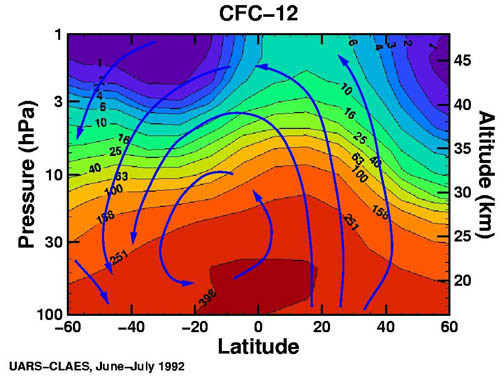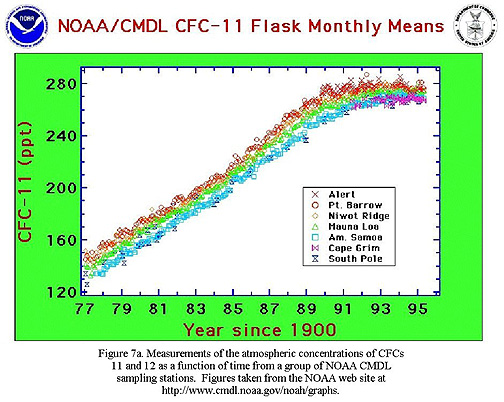Obviously, one cannot exclude the possibility of a long-term depletion of ozone due to anthropogenic causes, and specifically due to CFCs. But with each cause producing its characteristic "finger prints," proof must rely on a longer time series of more detailed observations (of CFC-specific altitude, latitude, and seasonal dependence). 2. While skeptical about the evidence for depletion, I consider the Antarctic ozone "hole" to be a genuine phenomenon, but have held a somewhat different view about its future. I have speculated (4) that--once there is sufficient chlorine present--the intensity of the hole is mainly controlled by the presence of polar stratospheric clouds (PSCs), and therefore by temperature and humidity rather than just atmospheric CFC concentration. Because the ongoing increase in atmospheric CO2 should gradually lower stratospheric temperatures (as a result of increased radiation loss), and the increase in methane should gradually increase stratospheric water vapor content (5), it is possible that the hole will persist--even if the chlorine concentration falls below the pre-1975 value. We don't know for certain where the chlorine threshold lies; it is possible therefore that an ozone hole could form in the Arctic if climate conditions favor the formation of PSCs there--even in the absence of CFC-produced chlorine (4).
In essence, this paragraph admits that Cl on polar stratospheric clouds causes ozone depletion in the Antarctic ozone hole. It also indicates that CFCs are a source of chlorine to the stratosphere.
Singer is a well-known skeptic on this; his stance on ozone depletion marginalized him even before he pushed his global warming skepticism with a petition hoax. While realizing that stating that runs the risk of being accused of an ad hominem argument, the remainder of what you supplied is clearly a skeptical argument, which is why I pointed this out.
It is absolutely true that low-level sources of HCl and HF "wash out" of the lower atmosphere and don't reach the stratosphere. If El Chichon increased stratospheric Cl by 10%, it was one of only two post-1970 eruptions powerful enough for major emissions to reach the stratosphere (the other being Pinatubo in 1991). Surely Singer doesn't think that one or two volcanoes are the major source of supply of Cl to the stratosphere. Or does he? This type of "uncertainty" argument is a typical skeptical way to argue.
Next question: does "total column" HCl and HF refer to tropospheric, mesospheric, and stratospheric concentrations, or just to stratospheric concentrations? That's not clear.
But the next paragraph is the most remarkable of all:
This situation changed in 1991, however, when Curtis Rinsland et al, repeating Zander's measurements of solar IR spectra, reported increases for HCl and HF of (5.1 + 0.7)% and (10.9 + 1.1)% per year, respectively, for the period 1977-1990, thus suggesting CFCs as a major source (13). Nevertheless, Rinsland et al conclude--and I tend to agree: "...in contrast to HF, there are significant natural as well as anthropogenic sources of HCl."
So Singer admits that CFCs are a major source of atmospheric HCl, but there are also natural sources. Well, there are, but this doesn't address or answer what the major sources of stratospheric Cl are. Is this a version of skeptical "bait and switch"? I can't tell without some context.
It appears that Singer's main line of argument is that CFCs are not a major source of stratospheric chlorine. Well, I posted this figure on another thread a few weeks ago; it shows stratospheric concentrations of CFCs as measured by an instrument (CLAES) on NASA's Upper Atmosphere Research Satellite (UARS):

The units are parts per trillion by volume (pptv).
The source of this figure is a massive and comprehensive resource entitled Stratospheric Ozone: An Electronic Textbook. Virtually any question about the subject of stratospheric ozone and ozone depletion can be answered with this resource, if you're willing to take the time to read it.
Regarding Singer's final point, I'd like to know what reference he's referring to, and how he would assess this figure:
